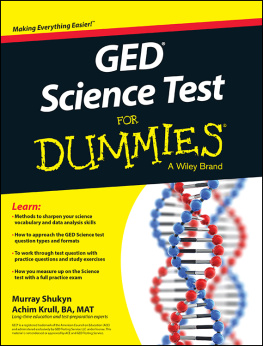

Copyright 2020 by ACT, Inc. All rights reserved.
Published by John Wiley & Sons, Inc., Hoboken, New Jersey.
Published simultaneously in Canada.
No part of this publication may be reproduced, stored in a retrieval system, or transmitted in any form or by any means, electronic, mechanical, photocopying, recording, scanning, or otherwise, except as permitted under Section 107 or 108 of the 1976 United States Copyright Act, without either the prior written permission of the Publisher, or authorization through payment of the appropriate per-copy fee to the Copyright Clearance Center, Inc., 222 Rosewood Drive, Danvers, MA 01923, (978) 750-8400, fax (978) 646-8600, or on the Web at www.copyright.com. Requests to the Publisher for permission should be addressed to the Permissions Department, John Wiley & Sons, Inc., 111 River Street, Hoboken, NJ 07030, (201) 748-6011, fax (201) 748-6008, or online at http://www.wiley.com/go/permissions.
Trademarks: Wiley and the Wiley logo are trademarks or registered trademarks of John Wiley & Sons, Inc. in the United States and other countries. All other trademarks are the property of their respective owners.
Limit of Liability/Disclaimer of Warranty: While the publisher and author have used their best efforts in preparing this book, they make no representations or warranties with respect to the accuracy or completeness of the contents of this book and specifically disclaim any implied warranties of merchantability or fitness for a particular purpose. No warranty may be created or extended by sales representatives or written sales materials. The advice and strategies contained herein may not be suitable for your situation. You should consult with a professional where appropriate. Neither the publisher nor author shall be liable for any loss of profit or any other commercial damages, including but not limited to special, incidental, consequential, or other damages.
For general information on our other products and services or for technical support, please contact our Customer Care Department within the United States at (800) 762-2974, outside the United States at (317) 572-3993 or fax (317) 572-4002.
Wiley publishes in a variety of print and electronic formats and by print-on-demand. Some material included with standard print versions of this book may not be included in e-books or in print-on-demand. If this book refers to media such as a CD or DVD that is not included in the version you purchased, you may download this material at http://booksupport.wiley.com. For more information about Wiley products, visit www.wiley.com.
ACT endorses the Code of Fair Testing Practices in Education and the Code of Professional Responsibilities in Educational Measurement, guides to the conduct of those involved in educational testing. ACT is committed to ensuring that each of its testing programs upholds the guidelines in each Code. A copy of each Code may be obtained free of charge from ACT Customer Services. (70), P.O. Box 1008, Iowa City, IA 522431008, 3193371429.
No part of this publication may be reproduced or transmitted in any form or by any means, electronic or mechanical, including photocopy, recording, or any information storage or retrieval system, without permission in writing from ACT, Inc. Inquiries concerning this publication should be mailed to:
ACT Publications
P.O. Box 168
Iowa City, Iowa 522430168
ISBN 978-1-119-63441-6 (paper)
ISBN 978-1-119-63474-4 (ePub)
Cover design: Wiley
Introduction
So you want to do well on the ACT science test. Thats a good goal to have! Whether youve already taken the test once or are planning to do so in the near or even distant future, this book will help you achieve your goal. There are three major factors that will determine how well you do on the ACT science test:
You need to be focused and diligent in your studies and preparation for the ACT science test. There is no getting around that. You need to put the time and effort into fully practicing the skills the test will be looking for. If you are reading this guide, it can be assumed that you are focused on achieving your goal of success and that you are willing to put the necessary time and effort into making it happen.
The third factor, guidance, is where this guide comes into play. Guidance is difficult to supply to yourself. Each time you take the ACT science test you dont know what is going to be on it, or the way the questions are structured, or the content that is going to be covered. Maybe you wonder how all science can be distilled down into a test that lasts only 35 minutes and has only 40 questions on it. There are so many facts, figures, formulas, theories, and everything else youve covered in school and have seen elsewhere. The great thing is that you arent expected to know every single fact, figure, and theory youve ever been taught when taking the ACT science test. This book will provide you with the guidance you need to succeed by telling you what you need to study, sharing details on how to prepare, and offering a lot of practice questions.
In , youll see examples of the three types of passages on the science test. Knowing how to handle and approach each of these passages is essential to accurately getting through the science section in the time allowed. Each passage type presents you with scientific information in a different format: perhaps a series of graphs and tables, a description of an experiment with different trials and results, or several contrasting hypotheses regarding some premise or data set. The examples will provide you with strategies for how to best approach and conquer each passage type.
In , youre going to see detailed explanations of the three reporting categories on the ACT science test and strategies for how to best approach each one in your studies. A science reporting category is ACTs way of breaking down the science test into smaller, more understandable subsections. Each reporting category is different and focuses on a specific area of science. Youll also be given official ACT science test sample questions tied directly to each reporting category so that you will know exactly what to expect when you take the test.
In youll get into more specifics about what you should do to review for success on the ACT science test. Remember: you dont need to remember everything youve ever learned in your science classes, just a few specific things. More important is that you need to have a solid overall grasp of the idea of science and how to perform and interpret scientific investigations. In this chapter youll start by exploring what the scientific method is, and then youll learn how to formulate a hypothesis, design an experiment, draw conclusions from the results, and make predictions based on those results. Again, all of this will be shown through explanations of official ACT science test sample items.
In youll get to review how to assess graphs and charts. The chapter starts with the basics of how to read a graph and moves on from there. A major focus is to help you not get overwhelmed by the different kinds of data presented. The chapter will help you learn how to pick out what you need from a graph or chart through provided examples and ignore the excess information given to you. The ACT science test is filled with graphs and charts of all kinds so having a solid understanding of how to read them is absolutely essential.
After reviewing the graphs and charts youll come to realize just how important and prevalent numbers and measurements are in science. provides an in-depth review of the major types of measurements and units you might encounter when taking the ACT science test, such as what the metric system is, how prefixes are used, and a detailed discussion of many of the most commonly used SI units. You arent expected to become an expert on every type of measure and unit. This chapter just helps you gain some familiarity with the measurements you might see on the ACT science test, increasing your confidence when taking the test.
Next page
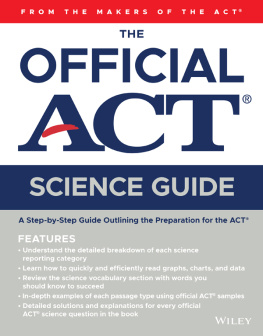
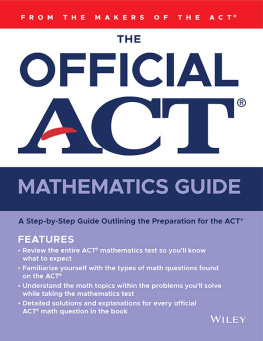
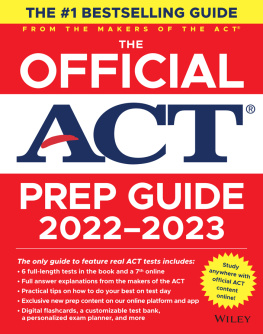

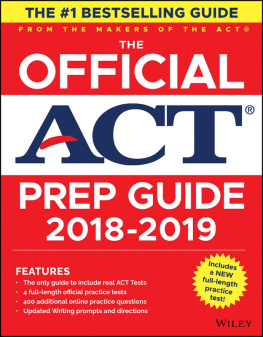
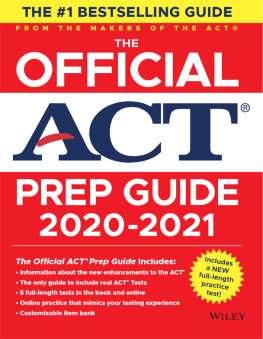


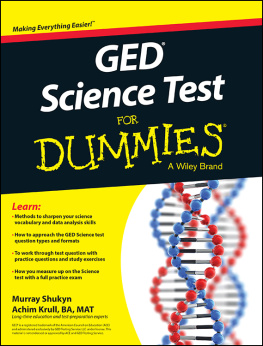
![ACT - The official ACT prep guide, [2018]: [the only official Prep Guide from the Makers of the ACT]](/uploads/posts/book/164684/thumbs/act-the-official-act-prep-guide-2018-the.jpg)
